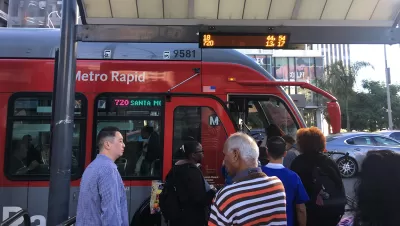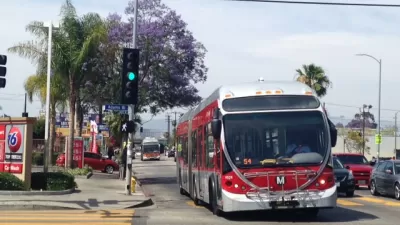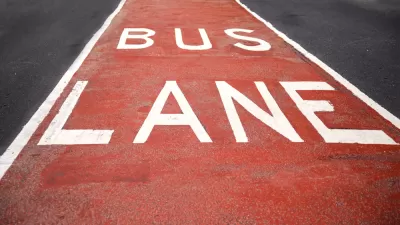Flagging ridership on Metro buses in Los Angeles redoubles the need to speed buses up with dedicated lanes, hopefully recovering lost riders and finding some news ones along the way, too.

Juan Matute, deputy director of the UCLA Institute of Transportation Studies, writes an opinion piece for the Los Angeles Times that digs into the spiraling consequences of declining ridership and bus speeds on the transit systems of Los Angeles and environs.
Average bus speeds in the Los Angeles metropolitan area have declined by 13.4% since 1994 to a sluggish 12 mph. The Los Angeles Department of Transportation’s DASH buses and Santa Monica’s Big Blue bus have been especially hard hit by congestion over that time period, with speeds declining 34% and 28%, respectively.
Ridership, not surprisingly, has plummeted along with speeds. The ripple effect of both is enormous: More traffic, of course, as people jettison Metro passes for cars; even slower traffic because of more congestion; taxpayer money wasted as transit drivers sit in all that traffic. Most concerning, however, is that slow buses with low occupancy rates are inefficient greenhouse gas emitters that could prevent Los Angeles from doing its part to fight climate change.
Matute places the magic number for ridership on a bus at eight. An average passenger total lower than that makes the bus less efficient than a driver alone in a car. If the transit agency is running buses that used renewable natural gas (captured from landfills and dairy farms) that number drops to four. L.A.-are buses are steadily approaching that threshold, according to Matute:
The occupancy of Los Angeles-area buses — roughly 4,000 run in L.A. and Orange counties each weekday — has declined from 14.8 passengers in 1994 to 12 passengers in 2017 (the latest complete data). And all signs show it’s still dropping. One of our greatest assets in the fight against climate change is turning into a liability.
Matute doesn't just sound the alarm, however. Also included in this opinion piece is a prescription for reversing all of that decline: bus-only lanes, like the Wilshire Boulevard lane that still frequently suffers from scofflaw automobile drivers and lack of enforcement. Matutue doesn't just recommend bus-only lanes, but also ways to better ensure that bus-only lanes speed buses up and attract new riders, like they've done in the San Francisco.
FULL STORY: L.A.’s slow buses aren’t just shedding riders, they’re becoming climate liabilities

Planetizen Federal Action Tracker
A weekly monitor of how Trump’s orders and actions are impacting planners and planning in America.

Congressman Proposes Bill to Rename DC Metro “Trump Train”
The Make Autorail Great Again Act would withhold federal funding to the system until the Washington Metropolitan Area Transit Authority (WMATA), rebrands as the Washington Metropolitan Authority for Greater Access (WMAGA).

The Simple Legislative Tool Transforming Vacant Downtowns
In California, Michigan and Georgia, an easy win is bringing dollars — and delight — back to city centers.

The States Losing Rural Delivery Rooms at an Alarming Pace
In some states, as few as 9% of rural hospitals still deliver babies. As a result, rising pre-term births, no adequate pre-term care and "harrowing" close calls are a growing reality.

The Small South Asian Republic Going all in on EVs
Thanks to one simple policy change less than five years ago, 65% of new cars in this Himalayan country are now electric.

DC Backpedals on Bike Lane Protection, Swaps Barriers for Paint
Citing aesthetic concerns, the city is removing the concrete barriers and flexposts that once separated Arizona Avenue cyclists from motor vehicles.
Urban Design for Planners 1: Software Tools
This six-course series explores essential urban design concepts using open source software and equips planners with the tools they need to participate fully in the urban design process.
Planning for Universal Design
Learn the tools for implementing Universal Design in planning regulations.
Smith Gee Studio
City of Charlotte
City of Camden Redevelopment Agency
City of Astoria
Transportation Research & Education Center (TREC) at Portland State University
US High Speed Rail Association
City of Camden Redevelopment Agency
Municipality of Princeton (NJ)





























